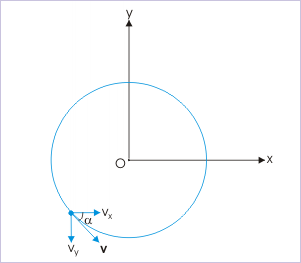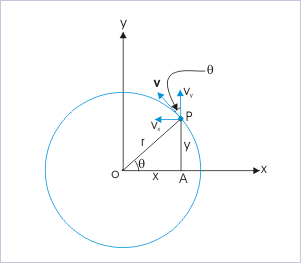| << Chapter < Page | Chapter >> Page > |
Questions and their answers are presented here in the module text format as if it were an extension of the treatment of the topic. The idea is to provide a verbose explanation, detailing the application of theory. Solution presented is, therefore, treated as the part of the understanding process – not merely a Q/A session. The emphasis is to enforce ideas and concepts, which can not be completely absorbed unless they are put to real time situation.
We discuss problems, which highlight certain aspects of the study leading to the uniform circular motion. The questions are categorized in terms of the characterizing features of the subject matter :
Problem : A particle moves in xy-plane along a circle of radius "r". The particle moves at a constant speed in anti-clockwise direction with center of circle as the origin of the coordinate system. At a certain instant, the velocity of the particle is i – √3 j . Determine the angle that velocity makes with x-direction.
Solution : The sign of y-component of velocity is negative, whereas that of x-component of velocity is positive. It means that the particle is in the third quadrant of the circle as shown in the figure.
Top view of uniform circular motion in xy-plane

The acute angle formed by the velocity with x-axis is obtained by considering the magnitude of components (without sign) as :
This is the required angle as measured in clockwise direction from x-axis. If the angle is measured in anti-clockwise direction from positive direction of x-axis, then
Problem : A particle moves in xy-plane along a circle of radius “r”. The particle moves at a constant speed in anti-clockwise direction with center of circle as the origin of the coordinate system. At a certain instant, the velocity of the particle is i – √3 j . Determine the angle that position vector makes with x-direction.
Solution : The sign of y-component of velocity is negative, whereas that of x-component of velocity is positive. It means that the particle is in the third quadrant of the circle as shown in the figure.
Top view of uniform circular motion in xy-plane

The acute angle formed by the velocity with x-axis is obtained by considering the magnitude of components (without sign) as :
But, we know that position vector is perpendicular to velocity vector. By geometry,
This is the angle as measured in clockwise direction from x-axis. If the angle is measured in anti-clockwise direction from positive direction of x-axis, then
Note : Recall the derivation of the expression of velocity vector in the previous module. We had denoted “θ” as the angle that position vector makes with x-axis (not the velocity vector). See the figure that we had used to derive the velocity expression.
Top view of uniform circular motion in xy-plane

As a matter of fact “θ” is the angle that velocity vector makes with y-axis (not x-axis). We can determine the angle “θ” by considering the sign while evaluating tan θ,
Problem : A particle moves with a speed 10 m/s in xy-plane along a circle of radius 10 m in anti-clockwise direction. The particle starts moving with constant speed from position (r,0), where "r" denotes the radius of the circle. Find the velocity of the particle (in m/s), when its position makes an angle 135° with x – axis.
Solution : The velocity of the particle making an angle "θ" with x – axis is given as :
Uniform circular motion

Here,
Here, both the components are negative.
Problem : Two particles tracing a circle of radius 10 m begin their journey simultaneously from a point on the circle in opposite directions. If their speeds are 2.0 m/s and 1.14 m/s respectively, then find the time after which they collide.
Solution : The particles approach each other with a relative speed, which is equal to the sum of their speeds.
For collision to take place, the particles need to cover the initial separation with the relative speed as measured above. The time for collision is, thus, obtained as :
Problem : Two particles “A” and “B” are moving along circles of radii " " and " " respectively at constant speeds. If the particles complete one revolution in same time, then prove that speed of the particle is directly proportional to radius of the circular path.
Solution : As the time period of the UCM is same,
Hence, speed of the particle is directly proportional to the radius of the circle.
Problem : Two particles “A” and “B” are moving along circles of radii " " and " " respectively at constant speeds. If the particles have same acceleration, then prove that speed of the particle is directly proportional to square root of the radius of the circular path.
Solution : As the acceleration of the UCM is same,
Hence, speed of the particle is directly proportional to square root of the radius of the circular path.

Notification Switch
Would you like to follow the 'Physics for k-12' conversation and receive update notifications?